无多普勒频移的海底混响单元散射模型卷积法
Posted kiki--xiunai
tags:
篇首语:本文由小常识网(cha138.com)小编为大家整理,主要介绍了无多普勒频移的海底混响单元散射模型卷积法相关的知识,希望对你有一定的参考价值。
%对混响的理解有帮助
%无多普勒频移的海底混响单元散射模型卷积法
clc;clear all;close all;
%参数设置============================================================
fs=200000; %采样频率
f0=30000; %中心频率
%k=1250000; %k =B/t =5kHz/4ms
B=5000;
c=1500; %声速
h=50; %距海底距离
u=-27;
rou=1; %密度
v=20;
azm=pi/6; %声纳水平方位角
startt=0.08; %混响起始时间
endt=0.3; %混响终止时间
T=0.005;%脉冲宽度
ts=0:1/fs:T-1/fs;%脉冲时间序列
s1=exp(j*2.*pi.*f0.*ts); %CW信号
k=B/T; %1000000
s2=exp(j*2.*pi.*(f0-B/2).*ts+j*pi.*k.*ts.*ts); %LFM信号
Ns=length(ts);%Ns 1000个点
k1=2*pi*f0/c;%波数 125.6637
k2=2*pi*(f0-B/2+k*ts)/c; %1*1000
% 信号时域=======================================================================
figure(1);
subplot(2,1,1);
plot(ts,real(s1));%取复信号的实部进行画图,如不取实部,系统自动取实部
axis([0 0.005 -1 1]); %axis([xmin xmax ymin ymax]),单轴xlim([0 5])
xlabel(‘时间/s‘);ylabel(‘幅度‘);title(‘CW信号‘);
subplot(2,1,2);
plot(ts,real(s2));
axis([0 0.005 -1 1]);xlabel(‘时间/s‘);ylabel(‘幅度‘);title(‘LFM信号‘);
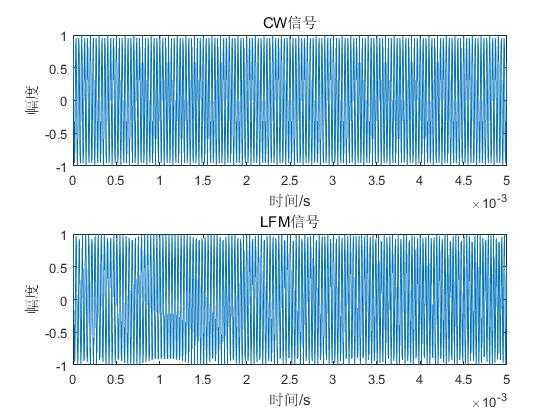
%信号频谱=================================================================
s1_fft=fft(s1);
s2_fft=fft(s2);
figure(2);
subplot(211);plot(1:length(s1_fft),s1_fft);xlabel(‘\\omega/\\pi‘);ylabel(‘|e^j^\\omega|‘);title(‘CW频域‘);
subplot(212);plot(1:length(s2_fft),s2_fft);xlabel(‘\\omega/\\pi‘);ylabel(‘|e^j^\\omega|‘);title(‘LFM频域‘);

X1=abs(fft(s1));%对复信号进行傅里叶变换,然后取模
X2=abs(fft(s2));
X1=X1/max(X1);
X2=X2/max(X2);
figure(3);
subplot(2,1,1);
f=fs*(0:Ns/2)/Ns;
plot(f,X1(1:Ns/2+1));
xlabel(‘频率/Hz‘);ylabel(‘归一化幅值‘);title(‘CW信号频谱‘);grid on;%添加网格
subplot(2,1,2);
f=fs*(0:Ns/2)/Ns;
plot(f,X2(1:Ns/2+1));
xlabel(‘频率/Hz‘);ylabel(‘归一化幅值‘);title(‘LFM信号频谱‘);grid on;
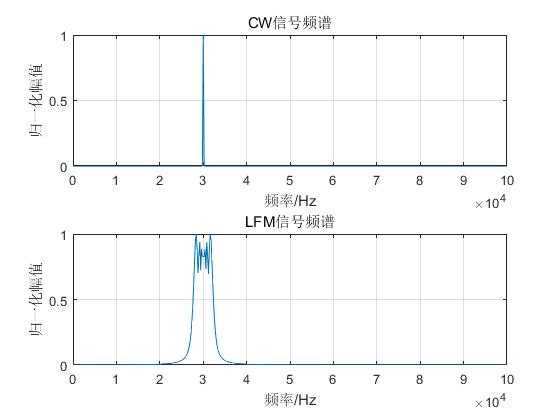
%===============================================================
%散射特征函数=============================================
Np=(endt-startt)*fs; %散射系数的点数24000个点,发射信号持续时间内采样的点
for th=startt:1/fs:endt-1/fs %混响时间 Np24000个点,th共循环44000次
r2=c*th/2; %c=1500
r1=c*(th-T)/2; %T=0.005
N=round((r2^2-r1^2)*azm/2); %azm=0.5236(pi/6)方位角
%%N=As*rou;
%%A=1;%发射信号的信号强度
%th=0.08,r2=60,r1=56.25,N=114;...........th=0.3,r2=224.9963,r1=221.2463,N=438
%随着混响时间的增加,混响点数也在增加
ain=randn(1,N); %th=0.08时,产生114个随机数
fai=randn(1,N)*2*pi; %th=0.08时,产生114个随机相位
for i=1:N
p1(i)=ain(i)*exp(j*fai(i)); %th=0.08时,产生114个信号点
p2(i)=ain(i)*exp(j*fai(i)); % th=0.08时,产生114个信号点
end
P1(round((th-startt)*fs)+1)=sum(p1)/r1^2;% 散射系数的时间序列 %P1共44000个点
P2(round((th-startt)*fs)+1)=sum(p2)/r1^2;
end
% 得到混响信号
R1=conv(s1,P1);%44000+1000-1 %1x44999
R2=conv(s2,P2);
Rr1=real(R1);
Rr2=real(R2);
figure(4);
subplot(2,1,1);
%%t=(0:Ns+Np-2)/fs;
t=startt:1/fs:endt+T-2/fs;%: 共44999个点
plot(t,Rr1/max(Rr1));
axis([startt endt+T-2/fs -1 1]);xlabel(‘时间/s‘);ylabel(‘归一化幅值‘);title(‘CW信号的混响‘);
subplot(2,1,2);
plot(t,Rr2/max(Rr2));
axis([startt endt+T-2/fs -1 1]);xlabel(‘时间/s‘);ylabel(‘归一化幅值‘);title(‘LFM信号的混响‘);
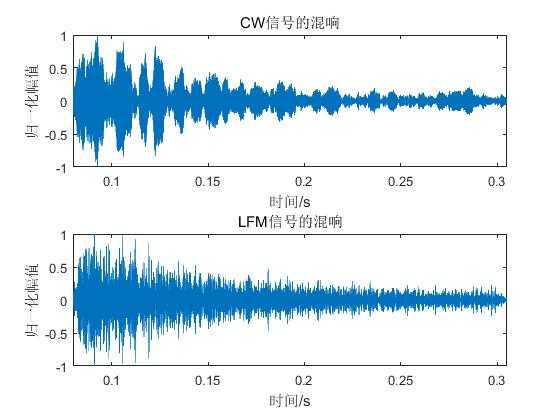
%=============================================================
%混响频谱================================================
F1=abs(fft(Rr1));
F2=abs(fft(Rr2));
figure(5);
subplot(2,1,1);
f1=fs*(0:(Ns+Np)/2)/(Ns+Np-1); %1*22500
plot(f1,F1(1:(Ns+Np)/2+1)/max(F1));xlabel(‘频率/Hz‘);ylabel(‘归一化幅值‘);title(‘CW信号的混响频谱‘);
subplot(2,1,2);
f2=fs*(0:(Ns+Np)/2)/(Ns+Np-1); %1*22500
plot(f2,F2(1:(Ns+Np)/2+1)/max(F2));xlabel(‘频率/Hz‘);ylabel(‘归一化幅值‘);title(‘LFM信号的混响频谱‘);
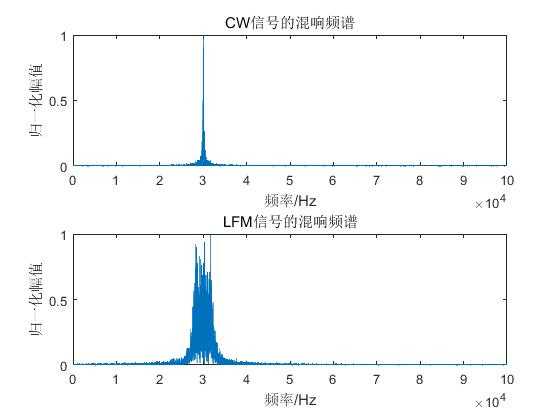
%===============================================================
%混响功率谱==========================================================
P1=fft(Rr1).*conj(fft(Rr1))/(Ns+Np-1);
P2=fft(Rr2).*conj(fft(Rr2))/(Ns+Np-1);
figure(6);
subplot(2,1,1);
plot(f1,P1(1:(Ns+Np)/2+1)/max(P1));
xlabel(‘频率/Hz‘);ylabel(‘归一化幅值‘);title(‘CW信号的混响功率谱‘);
subplot(2,1,2);
plot(f2,P2(1:(Ns+Np)/2+1)/max(P2));
xlabel(‘频率/Hz‘);ylabel(‘归一化幅值‘);title(‘LFM信号的混响功率谱‘);
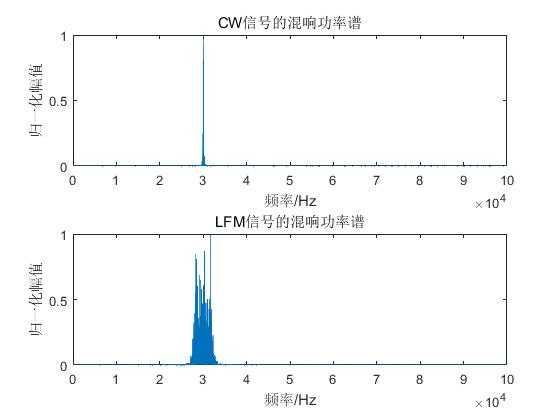
%=====================================================
%混响时间自相关===================================================
figure(7);
subplot(2,2,1);
Rx1=xcorr(Rr1);
plot(Rx1/max(Rx1));
xlabel(‘采样点数‘);ylabel(‘归一化幅值‘);title(‘CW信号的混响自相关‘);
subplot(2,2,2);
Rx2=xcorr(Rr2);
plot(Rx2/max(Rx2));
xlabel(‘采样点数‘);ylabel(‘归一化幅值‘);title(‘LFM信号的混响自相关‘);
subplot(2,2,3);
Rx1=xcorr(Rr1);
plot(Rx1/max(Rx1));
axis([33080 34120 -1 1]); %axis([xmin xmax ymin ymax]),单轴xlim([0 5])
xlabel(‘采样点数‘);ylabel(‘归一化幅值‘);title(‘CW信号的混响自相关局部放大‘);
subplot(2,2,4);
Rx2=xcorr(Rr2);
plot(Rx2/max(Rx2));
axis([33570 33630 -1 1]); %axis([xmin xmax ymin ymax]),单轴xlim([0 5])
xlabel(‘采样点数‘);ylabel(‘归一化幅值‘);title(‘LFM信号的混响自相关局部放大‘);

%================================================================
%生成混响瞬时值的概率密度,也可从工作空间的变量中直接查看
figure(8);
p=-1:0.01:1;
subplot(2,1,1);
Rr1g=Rr1/max(Rr1);
hist(Rr1g,p);
%axis([-1 1 0 1000]); %axis([xmin xmax ymin ymax])
xlim([-1 1]);xlabel(‘归一化幅值‘);ylabel(‘统计点数‘);title(‘CW信号混响瞬时值的概率分布‘);
subplot(2,1,2);
Rr2g=Rr2/max(Rr2);
hist(Rr2g,p);
%axis([-1 1 0 1000]); %axis([xmin xmax ymin ymax])
xlim([-1 1]);xlabel(‘归一化幅值‘);ylabel(‘统计点数‘);title(‘CW信号混响瞬时值的概率分布‘);
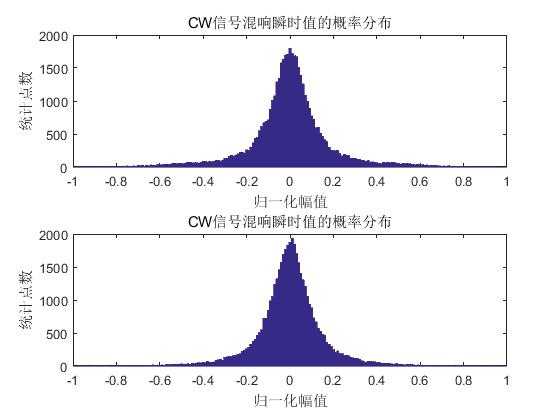
%==================================================================
%生成混响包络的概率密度函数
figure(9);
q=0:0.01:1;
subplot(2,1,1);
hist(abs(R1)/max(abs(R1)),q);
%axis([0 1 0 1000]); %axis([xmin xmax ymin ymax])
xlim([0 1]);
xlabel(‘归一化幅值‘);ylabel(‘统计点数‘);title(‘CW信号混响包络的概率分布‘);
subplot(2,1,2);
hist(abs(R2)/max(abs(R2)),q);
%axis([0 1 0 1000]); %axis([xmin xmax ymin ymax])
xlim([0 1]);
xlabel(‘归一化幅值‘);ylabel(‘统计点数‘);title(‘CW信号混响包络的概率分布‘);
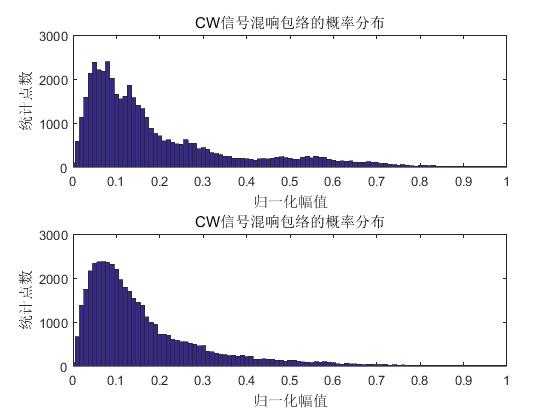
以上是关于无多普勒频移的海底混响单元散射模型卷积法的主要内容,如果未能解决你的问题,请参考以下文章